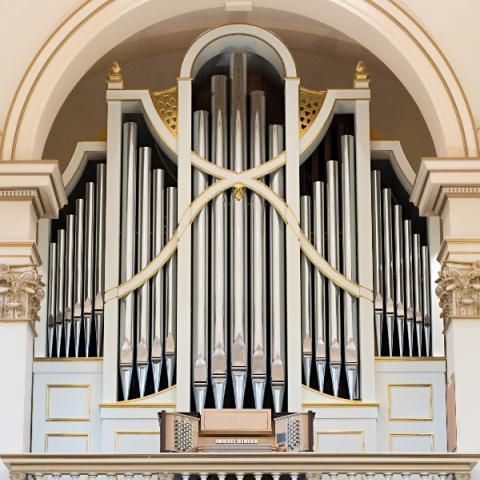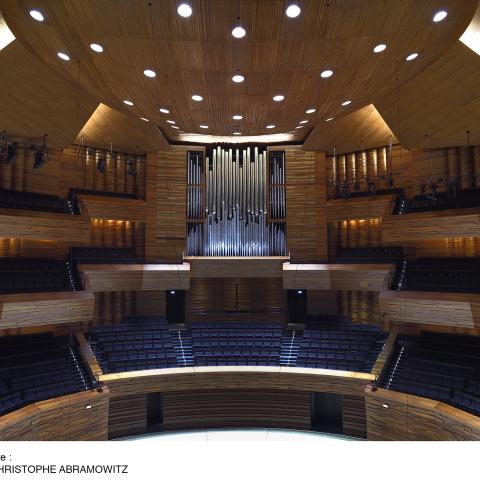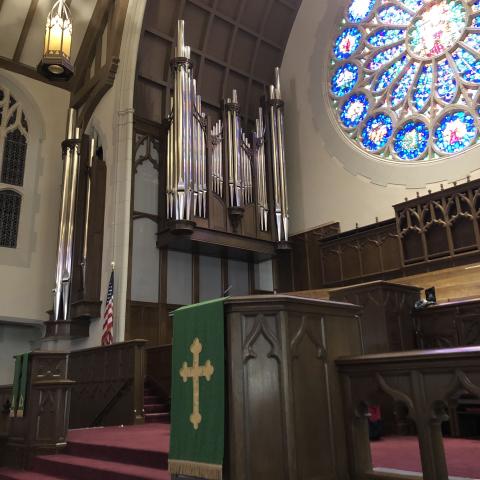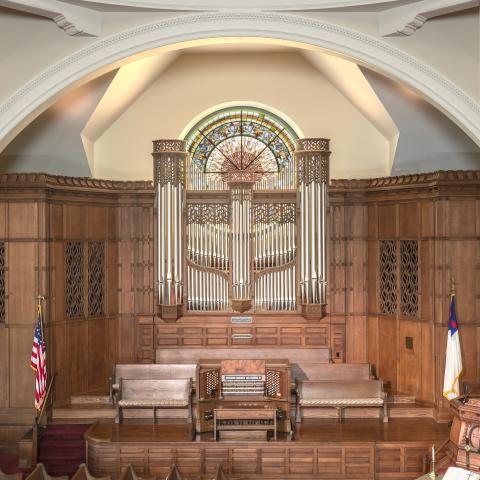Juget-Sinclair Organbuilders, Montréal, Québec, Canada
Christ Church, Episcopal, Pelham, New York
The making of Opus 51
Designing pipe organs has always been a big challenge. The large organs can only be the result of teamwork and are, in a way, a collective work. The point is also that church organs are among the only instruments not to be for private use, but for community use. The process of acquiring an organ is also far from the ordinary procedure of buying a good or a service, it is rather a human experience dotted with twists and turns that ultimately has a positive impact on an entire community.
It is with this in mind that we approached the project for Christ Church, Pelham. Although the beginnings of the project go back more than ten years, the winning conditions were met in 2017, and we consider ourselves privileged to have been given the mission of designing and manufacturing this instrument. As soon as we visited, we received the request to design a casework façade inspired by the motifs present in the church and to respect the Gothic Revival style, typical of the churches of this time, to create a symbiosis between the organ and the church.
The visual and technical concept
The main challenge in the visual design of the instrument was to emphasize verticality. This is why the five main pipes of the Pédale 16′ Principal (7–11) form the backbone of the concept. On each side, the subdivision of the pipe flats arouses visual excitement, as much by the use of small pipes as by the density of decorations and molding. The lateral pipe flats, whose starting point is lower, reinforce the central element, thus creating verticality within the whole. The zimbelstern star, gilded with 23-karat gold leaf, illuminates the façade by referring to the stained-glass window by William Jay Bolton, The Adoration of the Magi (1843). Although the space allocated to the organ is rather limited considering the requested stoplist, we were able to position the divisions without compromising access to the various components of the organ.
Choral music is very important in Pelham, and one of the mandates was to leave space for more than twenty singers between the console and the casework. The detached console has been positioned to leave as much space as possible for the singers while allowing the organist to conduct while accompanying. Finally, the constraints of depth and height guided the positioning of the windchests: The Pédale is on the ground, the Grand-Orgue on the first level aligned with the impost of the casework, and the Récit expressif on the second level, centered above the Grand-Orgue.
At ground level, the electric windchests of the large Pédale 16′ pipes (Principals 16′-8′, Soubasse 16′-8′, Trombone 16′-8′, and the first octave of the 8′ Violoncelle) are placed at the back and occupy the entire width of the church, the large pipes passing on each side of the swell box. The mechanical windchest, which includes the trebles of all the stops and the entire 4′ Flûte, is located under the Grand-Orgue, sharing the space with the three wedge bellows. On the first level, the Grand-Orgue is divided into two windchests, and the basses of the 8′ stops also stand on each side of the swell box. The five-rank Cornet is mounted over the Grand-Orgue pipes, just behind the façade. The Récit expressif occupies the second level above the Grand-Orgue and the Pédale. It is divided into two windchests, and the ceiling of the swell box follows the design of the façade to make it invisible.
The casework and console are in quarter-sawn white oak, stained and oiled. The music rack is made with myrtle veneer enhanced with ebony inlays. The keyboards are covered with bone, and the sharps are in solid ebony. The stop knobs are turned in black walnut, and the stop labels are in porcelain. According to our practice, the large wooden pipes, the frames, bellows, and windchests are mostly made of poplar and white oak. The 16′ and 8′ stopped pipes and the 4′ Pédale Flûte are made of white pine and cherry. Most of the mechanical parts are in beech, and the trackers are in carbon fiber. The metal pipes are made using three different alloys: the stopped pipes and flute mutations are 98% lead; all the reeds and the Récit principals are 52% tin; while the front pipes, the Grand-Orgue plenum, the gambas, and salicionals are 82% tin.
The tonal concept
From the beginning of the project, the committee’s choice centered on a French aesthetic, adapted to the North American context. Though this choice may seem unusual to support a liturgy inherited from the British tradition, the diversity of color and power of the foundations, the variety in mutations and reeds, combined with the efficiency of the swell box make it a very effective and versatile accompaniment instrument for the Episcopal liturgy.
Generally speaking, as voicers we are looking for refinement in sound colors and balance between each stop rather than power. At Christ Church, we used the progressive entailles de timbre (tuning slots) for the bass, tenor, and alto and cut-to-length trebles for the principals. The gambas are voiced with tuning slots only, while the harmonic flutes are cut to length. The windpressures are 90 mm for Grand-Orgue and Récit and 105 mm for the Pédale. The organ is tuned in equal temperament.
The Grand-Orgue division
The Grand-Orgue division is built on a 16′ Plein-jeu. If an 8′ plenum is registered, the low rank of the Fourniture V (22⁄3′–51⁄3′) will be automatically removed. The breaks in the Fourniture are on the C’s to favor clarity in polyphonic music. The Grand-Orgue has the four typical 8′ foundation stops of the French symphonic organ. These four stops are complementary in strength and timbre and can blend with each other. The Montre is rich and generous, and the trebles do not lose their intensity. The Flûte harmonique is the most ascending stop of the organ; it is a self-accompanying stop. The delicate Salicional brings richness when mixed with other 8′ stops while the Bourdon brings depth. The 16′ and 8′ Bourdons and the 4′ Flûte douce have chimneys. The Cornet V has two main roles: it can be considered a solo stop, and in the tutti, it compensates for the natural loss of power of the reed stops in the trebles. The Grand-Orgue 8′ Trompette is uninhibited without being vulgar and brings power to the whole organ. The Cromorne is in the French tradition, but in the fashion of the nineteenth century; it is rounder and warmer than its eighteenth-century predecessor. This therefore makes it a fairly versatile stop that can be used in Baroque, Romantic, and contemporary music. The Trompette is constructed with Bertounèche-type shallots and the Cromorne with slightly conical shallots in the bass and cylindrical shallots in the trebles.
The Récit expressif division
The Récit expressif is a great 16′ symphonic swell and has some of the most colorful stops of the organ. A secondary 8′ plenum is present to be able to dialogue with the Grand-Orgue. The breaks of the swell Plein-jeu are on the second, third, and fourth F so as not to coincide with those of the Grand-Orgue. The gambas have the narrowest scales of the organ. They bring clarity to the foundations of the whole organ and allow the Voix-céleste to be sparkling. The mutations are cylindrical and fluty according to French tradition. The Trompette and Clairon have harmonic trebles, which favors their presence in the church. Bertounèche reeds were used for Trompette and Clairon and tear-drop shallots for Bassons. The swell shades system we use allows the box to be opened completely, giving the most presence to the sound. This opening system also provides greater control and a better dynamic range between open and closed box. The full swell can literally disappear completely behind the Grand-Orgue foundations when the box is closed.
The Pédale division
Based on a 16′ Principal, the Pédale division has a variety of foundations covering the principal, flute, and gamba families. The 8′ Violoncelle is a chameleon stop that blends with the Principal as well as with the Bourdon. The 4′ Flûte is strong enough to allow it to be played solo. German-style plated shallots have been used for the 16′ Trombone and 8′ Trompette to allow these stops to be more versatile than typical French reeds. Although the Trombone is powerful enough to support the whole organ, it is much rounder than a Bombarde, and it is balanced with the large plenum and full swell to support the accompaniment of large hymns. The 8′ Trompette can be easily included in a Germanic plenum to reinforce the contrapuntal lines.
Project completion
The instrument-making process required nearly 18,000 man-hours of work from summer 2018 to fall 2019. Installation of the instrument was from October to November 2019, and the end of the voicing coincided with American Thanksgiving. The assembly of the casework and the mechanical action took place over two weeks, and voicing over seven weeks. During this period, we were able to establish close relationships with the community of Pelham, in particular with the main actors of the project, without whom all of this would not have been possible. We warmly thank the members of the organ committee who put trust in us: Martin A. Nash, Margaret Young (chairman), Jeffrey Hoffman, Father Matthew Mead, Kari Black, Jeff Bodenmann, and Kim De Beaumont, as well as all our hosts and collaborators in this project.
Robin Côté, President, Juget-Sinclair Organbuilders
The team of Juget-Sinclair organ builders
Robin Côté
François Couture
Dean Eckmann
Jean-Dominique Felx
Denis Juget
Michal Michalik
Alexander Ross
Stephen Sinclair
Mathieu Thomas-Guy
Philipp Windmöller
GRAND-ORGUE (Manual I)
16′ Bourdon
8′ Montre
8′ Bourdon
8′ Salicional
8′ Flûte harmonique (1–17 fr 8′ Bdn)
4′ Prestant
4′ Flûte douce
2′ Doublette
Fourniture V (V with 16′)
Cornet V (fr tenor F)
8′ Trompette
8′ Cromorne
Tremblant
II/I
RÉCIT EXPRESSIF (Manual II)
8′ Principal Amabile
8′ Bourdon
8′ Viole de gambe
8′ Voix-céleste
4′ Principal
4′ Flûte octaviante
2-2⁄3′ Nazard
2′ Piccolo
1-3⁄5′ Tierce
2′ Plein-jeu IV
16′ Basson
8′ Trompette
8′ Basson-Hautbois
4′ Clairon
Tremblant
PÉDALE
16′ Principal
16′ Soubasse
8′ Principal (ext 16′ Principal)
8′ Bourdon (ext 16′ Soubasse)
8′ Violoncelle
4′ Prestant (ext 16′ Principal)
4′ Flûte
16′ Trombone
8′ Trompette (ext 16′ Trombone)
I/P
II/P
General specification
61-note keyboards
32-note AGO pedalboard
Equal temperament
Multi-level electronic combination action
400 memory levels
10 general pistons
6 divisional pistons per division
Sequencer
35 stops, 42 ranks, 2,351 pipes






